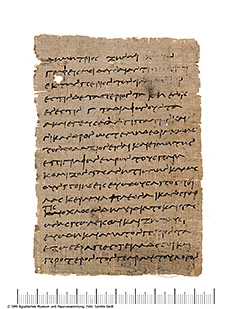BGU X 1994 = P.Zen.Pestm. 30 (P. 17487)
Who likes to drink wine which has gone bad? Nobody. And so it is not particularly surprising when a replacement for such wine is demanded, as in this business letter from a Demetrius to a Zenon from the 3rd century B.C., which was found in ancient Philadelpheia, today’s Gharabet el-Gerza, in the Fayum oasis.
Zenon had apparently asked Demetrios to give 100 drachmas to Antipatros from the proceeds of the remaining wine. Demetrios now declares in his letter that he cannot fulfill this wish. Of the 8 keramia of wine, 3 have gone bad and can therefore no longer be sold. In addition, Antipatros and a Nikandros have tasted this wine. Demetrios now asks Zenon to send him several keramia of fragrant wine. This wine seemed to be very popular. Demetrios reports that many people are around and are looking for this wine. He also hopes to get rid of the remaining wine on this occasion. At the end he reports that he had already sent to Zenon an account of Antipatros, which now amounts in detailed form up to the 11th Mecheir (four days before this letter) to a total of 190 drachmas.
Although an exact date is given at the end of the letter (the 15th Mecheir of a 6th regnal year), it is not possible to say exactly when this letter was written. This date can be either the 5th April 242 B.C. or the 4th April 241 B.C. in our current dating system. The reason for this is that it remains unclear in this letter whether the date refers to the Greek financial year or to the Egyptian year.
Demetrios reports that the people who Demetrios says were looking for the fragrant wine came to this place because the „farms“ were being sold. This is not about land that can be leased, but about the farming of taxes and other levies that have been leased. These deals are now apparently to be celebrated with wine, which is why Zenon is being asked for supplies.
Normally we do not know or know very little about the people we meet in the papyrus letters. Zenon, on the other hand, is famous. He was born around 285 B.C. in Kaunos, an ancient city in the southeast of the landscape Caria in Asia Minor, which he left to pursue a career in Egypt. Later he became business representative and private secretary of the Minister of Finance Apollonios and manager of his estate in Philadelpheia in the Fayum. Several thousand papyri have been preserved from his documents and form the famous Zenon Archive, whose papyri can now be found in many papyrus collections around the world.
In addition to its content, which gives us a good insight into the everyday life of a businessman at that time, this letter shows other interesting things. The text was finished on the back upside down, so that the end of the text and the address are below each other. The papyrus was also folded nine times so that the address was finally visible on the outside. Traces of these foldings are clearly visible. It is also noticeable that the writer, in contrast to the usual procedure, often observes the word boundaries and corrects his own text by crossing out errors and adding corrections above the line.



